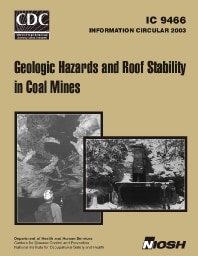Mining Publication: Geologic Hazards and Roof Stability in Coal Mines
Original creation date: October 2003
Authors: GM Molinda
NIOSHTIC2 Number: 20023684
Pittsburgh, PA: U.S. Department of Health and Human Services, Public Health Service, Centers for Disease Control and Prevention, National Institute for Occupational Safety and Health, DHHS (NIOSH) Publication No. 2003-152, Information Circular 9466; 1-33
The U.S. underground coal miner faces a continuing hazard from the fall of roof. At the root of many injuries and fatalities are weak or defective roof strata. Throughout mining history, millions of miles of entry have provided exposure of every conceivable geologic roof hazard. This report describes the geologic origin, association, and potential danger from the most common hazards. Discussions of weak rock include drawrock, rider coals, head coal, stackrock, and stream valley effects. Discontinuities, or roof defects, are described including, clay veins, slickensides, joints, and paleochannels. A number of examples from U.S. coalfields are used to document geologic structure and associated hazards. Roof fall analysis is a methodology used by NIOSH for hazard recognition and prevention; its application and benefit to the industry are discussed.

NIOSHTIC2 Number: 20023684
Pittsburgh, PA: U.S. Department of Health and Human Services, Public Health Service, Centers for Disease Control and Prevention, National Institute for Occupational Safety and Health, DHHS (NIOSH) Publication No. 2003-152, Information Circular 9466; 1-33
- ARBS - Analysis of Roof Bolt Systems - 2.5.02
- Development and Application of the Coal Mine Roof Rating (CMRR)
- Diagnosing and Controlling Moisture-Sensitive Roof in Coal Mines
- Geologic Characterization
- Ground Failures in Coal Mines with Weak Roof
- Horizontal Stress
- The Introduction of Roof Bolting to U.S. Underground Coal Mines (1948-1960): A Cautionary Tale
- Optimizing Secondary Roof Support with the NIOSH Support Technology Optimization Program (STOP)
- Performance Characteristics for Welded Wire Screen Used for Surface Control in Underground Coal Mines
- Reinforcing Coal Mine Roof with Polyurethane Injection: 4 Case Studies
- Support Design Procedures for Difficult Ground Conditions